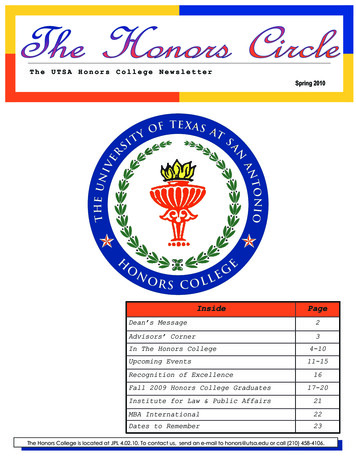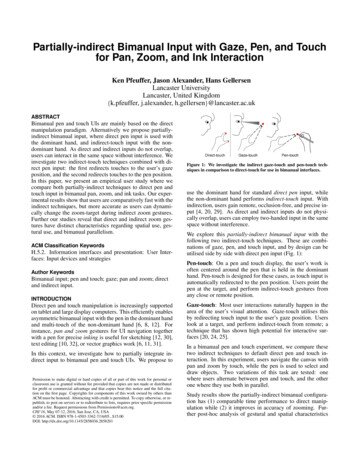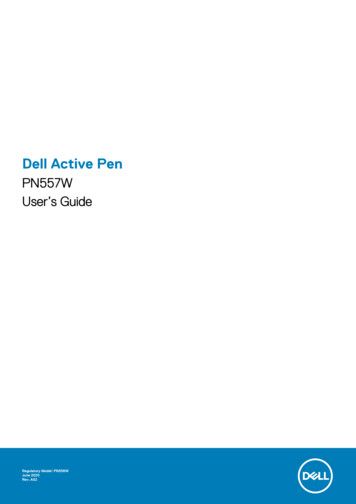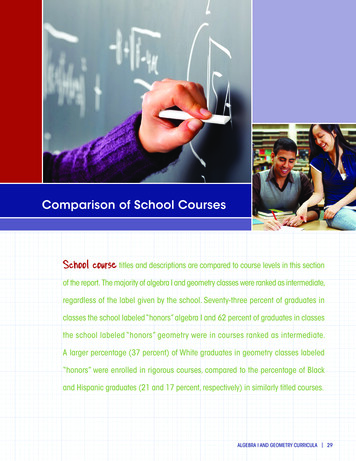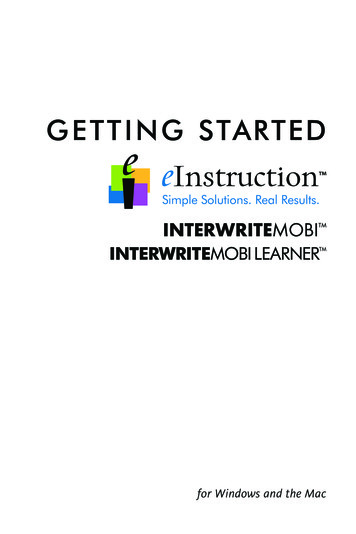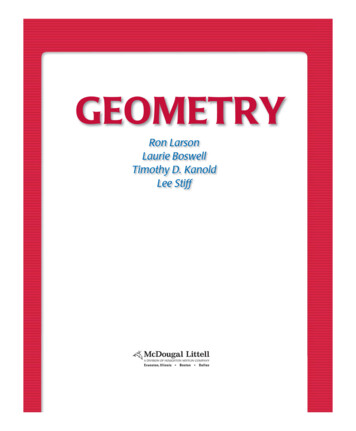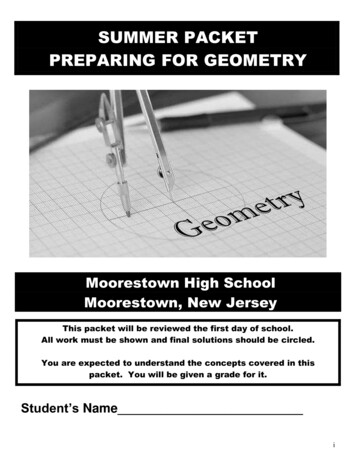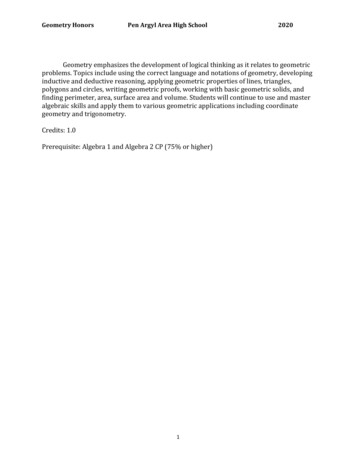
Transcription
Geometry HonorsPen Argyl Area High School2020Geometry emphasizes the development of logical thinking as it relates to geometricproblems. Topics include using the correct language and notations of geometry, developinginductive and deductive reasoning, applying geometric properties of lines, triangles,polygons and circles, writing geometric proofs, working with basic geometric solids, andfinding perimeter, area, surface area and volume. Students will continue to use and masteralgebraic skills and apply them to various geometric applications including coordinategeometry and trigonometry.Credits: 1.0Prerequisite: Algebra 1 and Algebra 2 CP (75% or higher)1
Geometry HonorsPen Argyl Area High School2020Unit 1: Introduction to the Basic Elements of GeometryUnit Outcomes:In this unit students will begin to work with the language of geometry, using correctnotations, and identifying geometric figures. Students will use postulates to identifycongruent segments, find the lengths of segments in the coordinate plane, and find themidpoint of a segment. Students will also name, measure, and classify angles, identifycomplementary and supplementary angles and classify polygons. Algebraic skills includesolving linear and quadratic equations, simplifying fractions, and simplifying radicals.Eligible Content:G.2.1.2.1 Calculate the distance and/or midpoint between two points on a number line oron a coordinate plane.G.2.2.1.1 Use properties of angles formed by intersecting lines to find the measures ofmissing angles.G.1.2.1 Recognize and/or apply properties of angles, polygons, and polyhedral.PA Core Standards:CC.2.3.8.A.3 Understand and apply the Pythagorean theorem to solve problems.CC.2.3.HS.A.11 Apply coordinate geometry to prove simple geometric theoremsalgebraicallyCC.2.3.8.A.2 Understand and apply congruence, similarity, and geometric transformationsusing various tools.CC.2.3.HS.A.3 Verify and apply geometric theorems as they relate to geometric figures.Essential Outcomes:A. Identify and model points, lines and planes, including intersection.B. Measure segments and calculate measurements using distance and midpointformulas. Express answers as simplified fractions and/or radicals.C. Measure and classify angles.D. Find missing segments and angles. Bisect angles and segments.E. Identify and measure vertical angles, linear pairs, complementary andsupplementary angles.F. Solve linear and quadratic equations to find angle measurements.G. Classify polygons based on sides and angles.H. Use the Pythagorean Theorem to solve right triangles2
Geometry HonorsPen Argyl Area High School2020Key Vocabulary:Acute AngleAngleAngle BisectorBisectCollinearCongruent figuresCoplanarDistance between two pointsExterior Angles of a PolygonInterior Angles of a polygonIntersecting LinesLineLine SegmentMidpointContent and Instructional Strategies:LectureDiscovery and application activitiesGeogebraVisual Aids/PowerpointWorksheetsText-based questionsReal life g ActivitiesExtra worksheetsPre-test study guidesEnrichment:Enrichment/challenge worksheetsWebsitesAssessment Criteria:Homework – e-book and/or worksheetsTeacher created quizzes, tests, and open-ended questionsApplication based assessmentsResources and Materials:E-bookComputer or ChromebookInterwrite Board or Smart BoardWorksheets3Obtuse AnglePythagorean TheoremPlanePolygonRayRegular PolygonStraight AngleVertex
Geometry HonorsPen Argyl Area High School2020Unit 2: Reasoning and Developing ProofsUnit Outcomes:In this unit, students will use inductive reasoning to make and test conjectures. They willuse deductive reasoning to make logical conclusions. While developing skills inunderstanding geometric relationships in diagrams, students will be introduced to the ideaof a mathematical proof. Finally, students will use properties of equality and the laws oflogic to prove statements about segments and angles. Algebraic skills include solving linearand quadratic equations.Eligible Content:G.1.3.2.1 Write, analyze, complete, or identify formal proofs (e.g., direct and/or indirectproofs/proofs by contradiction).PA Core Standards:CC.2.3.HS.A.3 Verify and apply geometric theorems as they relate to geometric figures.CC.2.3.HS.A.6 Verify and apply theorems involving similarity as they relate to plane figures.Essential Outcomes:A. Make conjectures based on inductive reasoning and find counter examples.B. Recognize and analyze conditional statements and write their inverses, converses,and contra-positives.C. Recognize, use, and rewrite definitions in biconditional statements.D. Use deductive reasoning to analyze the truth of a statement and form logicalarguments.E. Use postulates and diagrams involving points, lines, planes and anglesF. Use algebraic properties in proofs and reasoning.G. Justify statements about congruent segments and angle relationships, and writesteps in a proof.Key VocabularyPointLogic StatementDirect ProofIndirect ProofConjectureCounterexampleInductive ReasoningDeductive ReasoningPerpendicular LinesBiconditional StatementContent and Instructional Strategies:LectureDiscovery and application activitiesGeogebraVisual Aids/PowerpointWorksheetsText-based questionsReal life problems/connections4
Geometry HonorsPen Argyl Area High SchoolRemediation:WebsitesRe-teaching ActivitiesExtra worksheetsPre-test study guidesEnrichment:Enrichment/challenge worksheetsWebsitesAssessment Criteria:Homework – e-book and/or worksheetsTeacher created quizzes, tests, and open-ended questionsApplication based assessmentsResources and Materials:E-bookComputer or ChromebookInterwrite Board or Smart BoardWorksheets52020
Geometry HonorsPen Argyl Area High School2020Unit 3: Perpendicular and Parallel LinesUnit Outcomes:In this unit, students will classify angle pairs formed by three intersecting lines, study anglepairs formed by a line that intersects two parallel lines and use angle relationships to provelines parallel. Students will investigate slopes of lines and study the relationship betweenthe slopes of parallel and perpendicular lines. Students will find equations of lines. Finally,they will prove theorems about perpendicular lines and find the distance between parallellines in the coordinate plane. Algebraic skills include writing equations of lines andgraphing lines.Eligible Content:G.1.3.2.1 Write, analyze, complete, or identify formal proofs (e.g., direct and/or indirectproofs/proofs by contradiction).G.2.1.2.2 Relate slope to perpendicularity and/or parallelism (limit to linear algebraicequations).G.2.1.2.3 Use slope, distance, and/or midpoint between two points on a coordinate plane toestablish properties of a two-dimensional shape.G.2.2.1.2 Use properties of angles formed when two parallel lines are cut by a transversal tofind the measures of missing angles.PA Core Standards:CC.2.3.HS.A.3 Verify and apply geometric theorems as they relate to geometric figures.CC.2.3.HS.A.6 Verify and apply theorems involving similarity as they relate to plane figures.CC.2.3.HS.A.11 Apply coordinate geometry to prove simple geometric theoremsalgebraicallyCC.2.3.8.A.2 Understand and apply congruence, similarity, and geometric transformationsusing various tools.CC.2.3.HS.A.3 Verify and apply geometric theorems as they relate to geometric figures.Essential Outcomes:A. Identify relationships between pairs of lines and angles.B. Use angles formed by parallel lines intersected by a transversal.C. Prove and use results about parallel lines and transversals.D. Prove that lines are parallel, prove that lines are perpendicularE. Find and use slopes of lines and relate to parallel or perpendicular.F. Write equations of lines including lines parallel or perpendicular to another line.G. Graph lines in the coordinate plane using points and slope (include positive,negative, zero and undefined slope).H. Find distance between a point and a line.6
Geometry HonorsPen Argyl Area High SchoolKey Vocabulary:Parallel LinesPerpendicular LinesSkew LinesTransversalCorresponding AnglesCoordinate PlaneCoordinatesContent and Instructional Strategies:LectureDiscovery and application activitiesGeogebraVisual Aids/PowerpointWorksheetsText-based questionsReal life g ActivitiesExtra worksheetsPre-test study guidesEnrichment:Enrichment/challenge worksheetsWebsitesAssessment Criteria:Homework – e-book and/or worksheetsTeacher created quizzes, tests, and open-ended questionsApplication based assessmentsResources and Materials:E-bookComputer or ChromebookInterwrite Board or Smart BoardWorksheets72020
Geometry HonorsPen Argyl Area High School2020Unit 4: Congruent TrianglesUnit Outcomes:In this unit, the students will classify triangles, find measures of angles in triangles, identifycongruent figures, and prove triangles congruent. They will also use theorems aboutisosceles and equilateral triangles. Students will use coordinate geometry to investigatetriangle relationships. Algebraic skills include solving linear and quadratic equations.Eligible Content:G.1.2.1.1 Identify and/or use properties of triangles.G.1.2.1.3 Identify and/or use properties of isosceles and equilateral triangles.G.1.3.1.1 Identify and/or use properties of congruent and similar polygons or solids.G.1.3.2.1 Write, analyze, complete, or identify formal proofs (e.g., direct and/or indirectproofs/proofs by contradiction).PA Core Standards:CC.2.3.8.A.2 Understand and apply congruence, similarity, and geometric transformationsusing various tools.CC.2.3.HS.A.3 Verify and apply geometric theorems as they relate to geometric figures.CC.2.3.HS.A.13 Analyze relationships between two‐dimensional and three‐dimensionalobjects.CC.2.3.HS.A.6 Verify and apply theorems involving similarity as they relate to plane figures.Essential Outcomes:A. Classify triangles by their sides and angles.B. Find measurements of angles in triangles.C. Identify congruent figures and corresponding parts.D. Prove triangles congruent using definitions, postulates and theorems, includingSide-Side-Side (SSS), Side-Angle-Side (SAS), Angle-Side-Angle (ASA), and AngleAngle-Side (AAS).E. Use congruent triangles to prove statements about corresponding parts.F. Use coordinate geometry to investigate triangle relationships and properties ofcongruence.G. Use properties of isosceles, equilateral, and right triangles.Key Vocabulary:Acute triangleCorresponding partsEquilateral triangleIsosceles triangle-Base-Vertex- LegsObtuse triangleRight triangle-Legs-HypotenuseScalene triangleTriangle8
Geometry HonorsPen Argyl Area High SchoolContent and Instructional Strategies:LectureDiscovery and application activitiesGeogebraVisual Aids/PowerpointWorksheetsText-based questionsReal life g ActivitiesExtra worksheetsPre-test study guidesEnrichment:Enrichment/challenge worksheetsWebsitesAssessment Criteria:Homework – e-book and/or worksheetsTeacher created quizzes, tests, and open-ended questionsApplication based assessmentsResources and Materials:E-bookComputer or ChromebookInterwrite Board or Smart BoardWorksheets92020
Geometry HonorsPen Argyl Area High School2020Unit 5: Relationships in TrianglesUnit Outcomes:In this unit, students use properties of special segments in triangles. They exploreperpendicular bisectors, angle bisectors, medians, and altitudes along with the concurrencyof these segments. Concepts are related to real life problems about distance and center ofmass. Students relate side lengths and angle measures of a triangle to determine whichtriangles are possible. Finally, students extend methods for justifying and provingrelationships. Algebraic skills include proportions, linear equations and fractions.Eligible Content:G.1.2.1.1 Identify and/or use properties of triangles.G.1.2.1.3 Identify and/or use properties of isosceles and equilateral triangles.G.1.3.2.1 Write, analyze, complete, or identify formal proofs (e.g., direct and/or indirectproofs/proofs by contradiction).Pa Core Standards:CC.2.3.HS.A.3 Verify and apply geometric theorems as they relate to geometric figures.CC.2.3.HS.A.13 Analyze relationships between two‐dimensional and three‐dimensionalobjectsEssential Outcomes:A. Using properties of perpendicular bisectors and angle bisectors of triangles.B. Using properties of medians and altitudes of a triangle.C. Recognize and apply properties of inequalities to the angles and sides of a triangle.D. Use the triangle inequality theorem to identity possible triangles.Key Vocabulary:Altitude of a triangleCentroidCircumcenterIncenterIndirect ProofMedian of a triangleOrthocenterPerpendicular BisectorContent and Instructional Strategies:LectureDiscovery and application activitiesGeogebraVisual Aids/PowerpointWorksheetsText-based questionsReal life problems/connections10
Geometry HonorsPen Argyl Area High SchoolRemediation:WebsitesRe-teaching ActivitiesExtra worksheetsPre-test study guidesEnrichment:Enrichment/challenge worksheetsWebsitesAssessment Criteria:Homework – e-book and/or worksheetsTeacher created quizzes, tests, and open-ended questionsApplication based assessmentsResources and Materials:E-bookComputer or ChromebookInterwrite Board or Smart BoardWorksheets112020
Geometry HonorsPen Argyl Area High School2020Unit 6: QuadrilateralsUnit Outcomes:In this unit, students will find angle measures in polygons. They will investigate propertiesof parallelograms and use properties to conclude whether or not a quadrilateral is aparallelogram. Students will also study special quadrilaterals such as rhombi, rectangles,squares, trapezoids, and kites. Algebraic skills include solving linear and quadraticequations.Eligible Content:G.1.2.1.2 Identify and/or use properties of quadrilaterals.G.1.2.1.4 Identify and/or use properties of regular polygons.G.1.3.2.1 Write, analyze, complete, or identify formal proofs (e.g., direct and/or indirectproofs/proofs by contradiction).G.2.2.1.2 Use properties of angles formed when two parallel lines are cut by a transversal tofind the measures of missing angles.Pa Core Standards:CC.2.3.8.A.2 Understand and apply congruence, similarity, and geometric transformationsusing various tools.CC.2.3.HS.A.3 Verify and apply geometric theorems as they relate to geometric figures.CC.2.3.HS.A.6 Verify and apply theorems involving similarity as they relate to plane figures.Essential Outcomes:A. Find the measurements of interior and exterior angles of polygons.B. Recognize and apply properties of the sides and angles of parallelograms anddiagonals.C. Prove that a quadrilateral is a parallelogram.D. Recognize and apply properties of rectangles, rhombi, and squares.E. Apply and use properties of trapezoids and kites.F. Identify special quadrilaterals using properties and theorems.G. Use coordinate geometry to prove special quadrilaterals.Key ectangleRhombusSquareTrapezoid- Bases of Trapezoid- Legs of Trapezoid12
Geometry HonorsPen Argyl Area High SchoolContent and Instructional Strategies:LectureDiscovery and application activitiesGeogebraVisual Aids/PowerpointWorksheetsText-based questionsReal life g ActivitiesExtra worksheetsPre-test study guidesEnrichment:Enrichment/challenge worksheetsWebsitesAssessment Criteria:Homework – e-book and/or worksheetsTeacher created quizzes, tests, and open-ended questionsApplication based assessmentsResources and Materials:E-bookComputer or ChromebookInterwrite Board or Smart BoardWorksheets132020
Geometry HonorsPen Argyl Area High School2020Unit 7: Proportions and SimilarityUnit Outcomes:In this unit, students use ratios and proportions to solve geometric and real-life problems.Students will identify similar polygons, find the scale factor between two polygons, and usethe scale factor to find measurements and solve problems, including scale models. Studentswill learn the postulates and theorems to prove triangles are similar and continuedeveloping skills in formal proof. Also, students use proportions and the TriangleProportionality Theorem or its converse to find the lengths of segments related to trianglesor parallel lines. Algebraic skills include fractions, proportions and solving linear equations.Eligible content:G.1.2.1.1 Identify and/or use properties of triangles.G.1.3.1.1 Identify and/or use properties of congruent and similar polygons or solids.G.1.3.1.2 Identify and/or use proportional relationships in similar figures.G.1.3.2.1 Write, analyze, complete, or identify formal proofs (e.g., direct and/or indirectproofs/proofs by contradiction).G.2.2.1.2 Use properties of angles formed when two parallel lines are cut by a transversal tofind the measures of missing angles.PA Core Standards:CC.2.3.8.A.2 Understand and apply congruence, similarity, and geometric transformationsusing various tools.CC.2.3.HS.A.3 Verify and apply geometric theorems as they relate to geometric figures.CC.2.3.HS.A.13 Analyze relationships between two‐dimensional and three‐dimensionalobjects.Essential Outcomes:A. Write and simplify ratios and proportions.B. Use proportions to solve problems.C. Identify similar polygons and use their properties.D. Identify similar triangles.E. Prove two triangles are similar.F. Using proportionality theorems to solve problems.G. Interpret scale models and use scale factors to solve problems.Key Vocabulary:ConversionProportional relationshipScale FactorSimilar Figures14
Geometry HonorsPen Argyl Area High SchoolContent and Instructional Strategies:LectureDiscovery and application activitiesGeogebraVisual Aids/PowerpointWorksheetsText-based questionsReal life g ActivitiesExtra worksheetsPre-test study guidesEnrichment:Enrichment/challenge worksheetsWebsitesAssessment Criteria:Homework – e-book and/or worksheetsTeacher created quizzes, tests, and open-ended questionsApplication based assessmentsResources and Materials:E-bookComputer or ChromebookInterwrite Board or Smart BoardWorksheets152020
Geometry HonorsPen Argyl Area High School2020Unit 8: Right Triangles and TrigonometryUnit Outcomes:In this unit, students investigate side lengths and angles in triangles. They start by using thePythagorean Theorem to find the length of the third side in a right triangle, and then usethe Converse of the Pythagorean Theorem to classify triangles by angles. Students exploreratios of lengths of sides in special right triangles and use the results to find sidemeasurements. Finally, students apply trigonometric ratios to find side lengths and anglemeasures in triangles and apply to real-life problems. Algebraic skills include simplifyingradicals and solving proportions.Eligible Content:G.1.2.1.1 Identify and/or use properties of triangles.G.2.1.1.1 Use the Pythagorean Theorem to write and/or solve problems involving righttriangles.G.2.1.1.2 Use trigonometric ratios to write and/or solve problems involving right triangles.PA Core Standards:CC.2.3.8.A.2 Understand and apply congruence, similarity, and geometric transformationsusing various tools.CC.2.3.HS.A.3 Verify and apply geometric theorems as they relate to geometric figures.CC.2.3.HS.A.13 Analyze relationships between two‐dimensional and three‐dimensionalobjectsEssential Outcomes:A. Use the Pythagorean Theorem to find side lengths in right triangles. Expressanswers as simplified radicals.B. Use the converse of the Pythagorean Theorem to classify a triangle as right, obtuse,or acute.C. Use the properties of 45 45 90 and 30 60 90 triangles.D. Find trigonometric ratios (sine, cosine, and tangent) of an acute angle in a righttriangle.E. Apply trigonometric ratios to solve right triangles and apply to real life problems.Key Vocabulary:Cosine (of an angle)Pythagorean TheoremSine (of an angle)Tangent (of an acuteangle)Trigonometric Ratio16
Geometry HonorsPen Argyl Area High SchoolContent and Instructional Strategies:LectureDiscovery and application activitiesGeogebraVisual Aids/PowerpointWorksheetsText-based questionsReal life g ActivitiesExtra worksheetsPre-test study guidesEnrichment:Enrichment/challenge worksheetsWebsitesAssessment Criteria:Homework – e-book and/or worksheetsTeacher created quizzes, tests, and open-ended questionsApplication based assessmentsResources and Materials:E-bookComputer or ChromebookInterwrite Board or Smart BoardWorksheetsTape Measures and Clinometers172020
Geometry HonorsPen Argyl Area High School2020Unit 9: CirclesUnit Outcomes:In this unit, students investigate aspects of circles. They start by drawing tangents to circlesand seeing how a tangent to a circle is related to the radius at the point of tangency. Theyuse intercepted arcs of circles to measure angles formed by chords in a circle and tomeasure angles formed by secants and tangents to a circle. They explore relationshipsbetween segment lengths of chords that intersect in a circle, and they investigaterelationships between segment lengths of secants and tangents to a circle. Finally, they usethe standard equation of a circle to graph and describe circles in a coordinate plane.Algebraic skills include solving linear and quadratic equations and completing the square.Eligible Content:G.1.1.1.1 Identify, determine, and/or use the radius, diameter, segment, and/or tangent of acircle.G.1.1.1.2 Identify, determine, and/or use the arcs, semicircles, sectors, and/or angles of acircle.G.1.1.1.3 Use chords, tangents, and secants to find missing arc measures or missingsegment measures.PA Core Standards:CC.2.3.HS.A.8 Apply geometric theorems to verify properties of circles.CC.2.3.HS.A.9 Extend the concept of similarity to determine arc lengths and areas of sectorsof circles.CC.2.3.HS.A.13 Analyze relationships between two‐dimensional and three‐dimensionalobjects.CC.2.2.HS.D.3 Extend the knowledge of arithmetic operations and apply to polynomials.Essential Outcomes:A. Identify segments and lines related to circles – radius, diameter, chord, secant, andtangent.B. Identify central angles, major arcs, minor arcs, and semicircles and find theirmeasures.C. Recognize and use relationships between arcs and chords.D. Find measures of inscribed angles of circles.E. Use angles formed by tangents, chords, and secant lines that intersect a circle.F. Find segment lengths in circles.G. Identify the center and radius from an equation and write the equation of a circle instandard form.H. Use completing the square to find center and radius from the equation of a circle notwritten in standard form.I. Completing the square with a 0J. Completing the square with a 018
Geometry HonorsPen Argyl Area High SchoolContent and Instructional Strategies:LectureDiscovery and application activitiesGeogebraVisual Aids/PowerpointWorksheetsText-based questionsReal life g ActivitiesExtra worksheetsPre-test study guidesEnrichment:Enrichment/challenge worksheetsWebsitesAssessment Criteria:Homework – e-book and/or worksheetsTeacher created quizzes, tests, and open-ended questionsApplication based assessmentsResources and Materials:E-bookComputer or ChromebookInterwrite Board or Smart BoardWorksheets192020
Geometry HonorsPen Argyl Area High School2020Unit 10: Areas of Polygons and CirclesUnit Outcomes:In this unit, students will find measurements of perimeter, circumference, and area forplane figures. Beginning with circles, students will find circumference and arc lengthmeasurements around a circle and area of both the whole circle and sectors of circles.Students will then find perimeter and area of triangles and quadrilaterals, includingparallelograms and trapezoids. Lastly, students will find area of regular polygons. Studentswill find areas of shaded regions of overlapping shapes. Algebraic skills include fractions,solving linear equations, rewriting formulas, and applying trigonometry.Eligible Content:G.2.2.2.1 Estimate area, perimeter, or circumference of an irregular figure.G.2.2.2.2 Find the measurement of a missing length, given the perimeter, circumference, orarea.G.2.2.2.3 Find the side lengths of a polygon with a given perimeter to maximize the area ofthe polygon.G.2.2.2.4 Develop and/or use strategies to estimate the area of a compound/compositefigure.G.2.2.2.5 Find the area of the sector of a circle.G.2.2.3.1 Describe how a change in the linear dimension of a figure affects its perimeter,circumference, and area.PA Core StandardCC.2.3.HS.A.3 Verify and apply geometric theorems as they relate to geometric figures.CC.2.3.HS.A.8 Apply geometric theorems to verify properties of circles.CC.2.3.HS.A.9 Extend the concept of similarity to determine arc lengths and areas of sectorsof circles.CC.2.3.HS.A.13 Analyze relationships between two‐dimensional and three‐dimensionalobjects.Essential Outcomes:A. Find circumference and arc lengths of circles.B. Find areas of circles and sectors of circles.C. Find the area of triangles, parallelograms, and trapezoids.D. Understand perimeter as distance around a figure.E. Apply perimeter and area to real-life applications.F. Find areas of regular polygons, including problems that use trig to calculate angles.G. Find the area of the shaded regions of composite figures including inscribed andcircumscribed polygons.20
Geometry HonorsPen Argyl Area High SchoolKey Vocabulary:Arc length of a eterSector of a CircleContent and Instructional Strategies:LectureDiscovery and application activitiesGeogebraVisual Aids/PowerpointWorksheetsText-based questionsReal life g ActivitiesExtra worksheetsPre-test study guidesEnrichment:Enrichment/challenge worksheetsWebsitesAssessment Criteria:Homework – e-book and/or worksheetsTeacher created quizzes, tests, and open-ended questionsApplication based assessmentsResources and Materials:E-bookComputer or ChromebookInterwrite Board or Smart BoardWorksheets212020
Geometry HonorsPen Argyl Area High School2020Unit 11: Solids, Surface Area and VolumeUnit Outcomes:In this unit, students identify and name solids and describe cross sections of solids.Students will explore and understand surface area of solids and calculate surface area ofprisms, cones, cylinders, pyramids, and spheres. Students will explore and understand theconcept of volume of solids and find the volume of prisms, cones, cylinders, pyramids,cones, and spheres. Students will be permitted to use the state formula sheet and emphasiswill be placed on understanding concepts and comparing measurements. Algebraic skillsinclude solving linear equations and rewriting formulas.Eligible Content:G.1.1.1.1 Identify, determine, and/or use the radius, diameter, segment, and/or tangent of acircle.G.1.2.1.5 Identify and/or use properties of pyramids and prismsG.2.3.1.1 Calculate the surface area of prisms, cylinders, cones, pyramids, and/or spheres.Formulas are provided on a reference sheetG.2.3.1.2 Calculate the volume of prisms, cylinders, cones, pyramids, and/or spheres.Formulas are provided on a reference sheet.G.2.3.1.3 Find the measurement of a missing length, given the surface area or volume.G.2.3.2.1 Describe how a change in the linear dimension of a figure affects its surface areaor volume (e.g., How does changing the length of the edge of a cube affect the volume of thecube?).PA Core Standards:CC.2.3.HS.A.3 Verify and apply geometric theorems as they relate to geometric figures.CC.2.3.8.A.1 Apply the concepts of volume of cylinders, cones, and spheres to solve real‐world and mathematical problems.CC.2.3.HS.A.12 Explain volume formulas and use them to solve problems.CC.2.3.HS.A.13 Analyze relationships between two‐dimensional and three‐dimensionalobjects.CC.2.3.HS.A.14 Apply geometric concepts to model and solve real‐ world problems.Essential Outcomes and Related Standards:A. Identify and name three dimensional figuresB. Find the surface area of prisms and cylinders.C. Find the surface area of pyramids and cones.D. Find the volume of prisms and cylinders.E. Find the volume of pyramids and cones.F. Find the volume and surface area of spheres.22
Geometry HonorsPen Argyl Area High School2020Key Vocabulary:Altitude of a solidBase of a solidConeCylinder- altitude- right vs. oblique- base- vertex- altitudeCubeEdgeFaceLateral facePolyhedronPrism- lateral facesPyramid- base, lateral face, altitude,vertexRectangular PrismSphereSurface AreaVolumeContent and Instructional Strategies:LectureDiscovery and application activitiesGeogebraVisual Aids/PowerpointWorksheetsText-based questionsReal life g ActivitiesExtra worksheetsPre-test study guidesEnrichment:Enrichment/challenge worksheetsWebsitesAssessment Criteria:Homework – e-book and/or worksheetsTeacher created quizzes, tests, and open-ended questionsApplication based assessmentsResources and Materials:E-bookComputer or ChromebookInterwrite Board or Smart BoardWorksheets23
Geometry HonorsPen Argyl Area High School2020Unit Algebra ReviewUnit Outcomes:In this unit students will review algebra topics from previous years and applying them togeometric concepts. Topics include simplifying rational expressions, factoring algebraicexpressions, adding, subtracting, multiplying, and dividing rational expressions, factoringand solving quadratic equations.Eligible Content:A2.1.2.2.1 Factor algebraic expressions, including difference of squares and trinomials.A2.1.3.1.1 Write and/or solve quadratic equations (including factoring and using theQuadratic Formula).A2.1.2.2.1 Factor algebraic expressions, including difference of squares and trinomials.A2.1.2.2.2 Simplify rational algebraic expressions.PA Core Standards:CC.2.2.HS.D.9 Use reasoning to solve equations, and justify the solution method.CC.2.2.HS.D.3 Extend the knowl
Geometry Honors Pen Argyl Area High School 2020 2 Unit 1: Introduction to the Basic Elements of Geometry Unit Outcomes: In this unit students will begin to work with the language of geometry, using correct notations, and identifying geometric figures. Students will use postulates to identify


